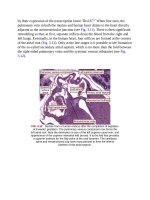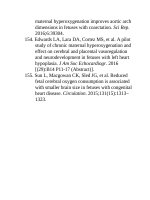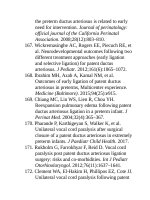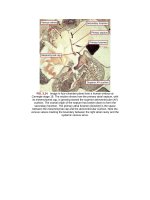Andersons pediatric cardiology 1843
Bạn đang xem bản rút gọn của tài liệu. Xem và tải ngay bản đầy đủ của tài liệu tại đây (137.67 KB, 3 trang )
ventriclephysiologytheopportunitytofeedorallyondemandwithoutforced
gastrictubesupplementation.Thisisthecaseevenwhenindwellingumbilical
arterialcathetersareinsituorprostaglandininfusionsarebeinggiven.Incases
whereenteralnutritionisestablished,serialandcarefulmonitoringofthe
abdominalexamandstoolisparamount.Theclinicianmusthavealowthreshold
fordiscontinuationofenteralfeedsifthereisanyevidenceofshockorpoor
intestinalperfusion.Althoughhumanmilkisthepreferredoptionforenteral
feeding,otheroptionsincludedonormilkorastandard-calorieneonatalformula.
Ifthereisacontraindicationtoenteralfeedingoranydelayintheinitial
palliation,oneshouldconsiderinitiationoftotalparenteralnutrition(TPN)early
andadvancetofullfluid(100to120mL/kgperday),calorie(90to100kcal/kg
perday),andprotein(1.5to3g/kgperday)goals.Elementalsupplementsof
sodium,potassium,calcium,phosphorus,magnesium,zinc,andcarnitineare
alsocommon.
SurgicalOptionsintheNeonate
SurvivaltobirthoftheindividualwithafUVHispossibleduetothepresenceof
thearterialduct,whichcanallowthedominantventricletoperformsystemic
work.ThediagnosesincludedinthegeneralcategoryoffUVHcanbedivided
intoseveralcategoriesthatcorrespondtosurgicalinterventions.Thepatientmay
haveobstructiontopulmonarybloodflow(suchastricuspidatresiawith
normallyrelatedgreatvessels),obstructiontosystemicbloodflow(suchas,
hypoplasticleftheartsyndrome),orabsenceofobstructiontoeithercirculation.
Neonatalpalliationisdifferentforeachoftheseconditions.
RestrictedorDuct-DependentPulmonaryBlood
Flow
Patientswithpulmonaryatresiaorsevereobstructiontopulmonarybloodflow
willrequireastablesourceofpulmonarybloodflowthatwillnotresultin
excessivehypoxemiaorexcessivepulmonarybloodflowattheexpenseof
systemicbloodflow.Excessivepulmonarybloodflowwillleadtoheartfailure
orelevationofPVR,whichwillcomplicatesubsequentsurgicalpalliation.
Optionsincludeasystemic-to-pulmonaryarteryshuntorductalstenting.The
mostcommonsurgicallycreatedsystemic-to-pulmonaryarteryshuntisthe
modifiedBlalock-TaussigshuntdescribedbyDeLevalandcolleagues(Fig.
71.1).65,66Hereaninterpositiongraftofexpandedpolytetrafluoroethylene
(ePTFE)isusedtoconnectasystemicartery,mostcommonlytheinnominate
artery,totheipsilateralbranchpulmonary.Otheroptionsmayincludeacentral
shuntinwhichtheePTFEgraftistakenfromtheascendingaortatothemainor
aproximal-branchpulmonaryartery(Fig.71.2).67Othershuntsincludedirect
connectionoftheascendingaortatotherightpulmonaryartery(Waterston
shunt)anddirectconnectionoftheleftpulmonaryarterytothedescending
thoracicaorta(Pottsshunt).68,69Theseareuncommonlyusedforsurgical
palliation,althoughthePottsshunthasfoundnewlifeinthetreatmentofendstagepulmonaryhypertension.Thedecisionregardingshuntconstruction
dependsonthepatient'sspecificanatomy.Patientswithnormallyrelatedgreat
vesselsandtypicalarchbranchinganatomycouldundergoamodifiedBlalockTaussigshunt.Individualswithpulmonaryatresiawithanintactseptumand
smallbranchpulmonaryarteriesorthosewithabnormalarchbranchingsuchas
anomalousoriginoftherightsubclavianarterywithanisolatedrightcarotid
arteryasthefirstvesselmaybenefitfromconstructionofacentralshuntfrom
theaortatothemainpulmonaryartery.
FIG.71.1 AmodifiedBlalock-Taussigshuntusinganexpanded
polytetrafluorethylenegrafttoconnecttherightsubclavianarterytothe
rightpulmonaryartery.(FromTweddellJS.Principlesandpracticeof
pediatricsurgery.In:OldhamKT,ColombaniPM,FogliaRP,etal,eds.
AnnalsofSurgery.Philadelphia:LippincottWilliams&Wilkins;2006:1804.)
FIG.71.2 Acentralshuntusinganexpandedpolytetrafluoroethylenegraft
fromtheascendingaorta(Ao)tothemainpulmonaryartery(PA).(From
GatesRN,LaksH,JohnsonK.Side-to-sideaorto-Gore-Texcentralshunt.
AnnThoracSurg.1998;65[2]:515–516.)
Stentingofthearterialducttoprovideastablesourceofpulmonaryblood
flowwasfirstreportedin1992.70Arecentretrospectivemulticenteranalysis
suggeststhatductstentingmayprovideequivalentresultstoasurgicalshuntin
patientswithsuitableanatomy.71Unlikethepatentarterialductasanisolated
lesion,theductincyanoticheartdiseasehaswidemorphologicvariability.It
maybelongandcurled,renderingstentimplantationmorechallenging.The
newercoronarystentshavebetterflexibilityandtrackability,makingductal
stentingsafer.72Decisionsregardingshunttypeortheuseofductstenting
frequentlyvarybyinstitution,beingbasedonanatomyandperceivedlocal
expertise;asyetnouniversallyacceptedcriteriahavebeendeveloped.However,
astechniquesimprove,ductstentingwillplayabiggerroleininitialpalliation.









